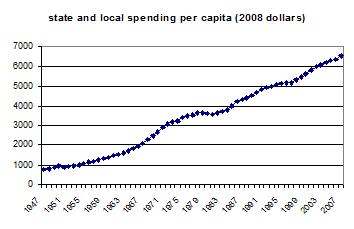(San Francisco) There is a lot of talk about deep cuts in state and local government spending, only partly offset by the federal stimulus. Here is a historical graph of total state and local expenditures, adjusted for inflation and for population growth:

[revised, 10:30 am Eastern Time] The growth has been fairly continuous, apart from a dip in real spending in the Reagan years. Adjusted spending in 1982 was lower than in 1978, despite sharply increased need because of the recession. I don’t know for sure, but I suspect that at other times, the growth has been driven by: health entitlements, prison costs, and higher education (in descending order of magnitude). Spending for other purposes is probably close to flat.
Both the standard liberal and conservative narratives are a little off. Liberals are wrong to say that we’ve just lived through a period of conservative retrenchment in which local and state governments have shrunk. Expenditures are much bigger in real terms than they were in the liberal 60s. But conservatives are wrong to complain about a growing “welfare state.” If most expenditures cover prisons, education for relatively advantaged young adults who can attend college, and medical technology, this is hardly “welfare”–even broadly defined.
The data I could find ended in 2007. We’ll see what happens next.

